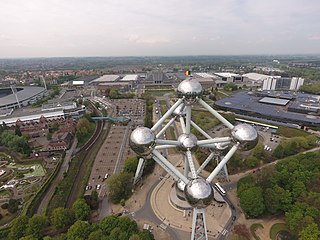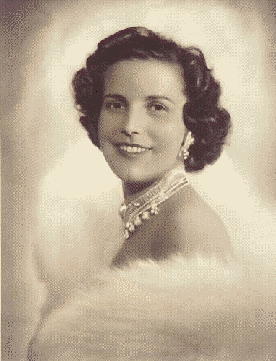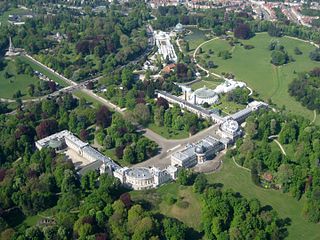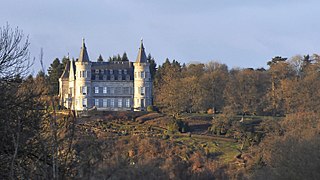
Leopold II was the second King of the Belgians from 1865 to 1909, and the founder and sole owner of the Congo Free State from 1885 to 1908.

The Heysel Plateau or Heysel Park, usually shortened to Heysel or Heizel, is a neighbourhood, park and exhibition space in Laeken, northern Brussels, Belgium, where the Brussels International Exposition of 1935 and the 1958 Brussels World's Fair took place.

Astrid of Sweden was a member of the Swedish House of Bernadotte and later became Queen of the Belgians as the first wife of King Leopold III. Following her marriage to Leopold in November 1926, she assumed the title of Duchess of Brabant. Astrid held the position of Queen of the Belgians from 23 February 1934 until her death in 1935. Known for her charitable efforts, she focused particularly on causes related to women and children.

Princess Lilian of Belgium, Princess of Réthy was the second wife of King Leopold III of Belgium. Born in the United Kingdom and raised in Belgium, she became a volunteer as a car driver that transported wounded Belgian and French to the hospital in Bruges during World War II. Lilian married King Leopold III in 1941 and became consort of the Belgian monarch. The couple had three children. She was also a stepmother to Leopold III's children from Queen Astrid and became the "first lady" of Belgium during the first nine years of her stepson King Baudouin's reign. Her charity work revolved around medicine and cardiology.

Laeken or Laken is a residential suburb in the north-western part of the Brussels-Capital Region, Belgium. It belongs to the municipality of the City of Brussels and is mostly identified by the Belgian postal code: 1020. Prior to 1921, it was a separate municipality.

The Royal Palace of Brussels is the official palace of the King and Queen of the Belgians in the centre of the nation's capital, Brussels. However, it is not used as a royal residence, as the king and his family live in the Royal Palace of Laeken in northern Brussels. The website of the Belgian Monarchy describes the function of the Royal Palace as follows:
The Royal Palace is where His Majesty the King exercises his prerogatives as Head of State, grants audiences and deals with affairs of state. Apart from the offices of the King and the Queen, the Royal Palace houses the services of the Grand Marshal of the Court, the King's Head of Cabinet, the Head of the King's Military Household and the Intendant of the King's Civil List. The Royal Palace also includes the State Rooms where large receptions are held, as well as the apartments provided for foreign Heads of State during official visits.

The Palace of Laeken or Castle of Laeken is the official residence of the King of the Belgians and the Belgian royal family. It lies in the Brussels-Capital Region, 5 km (3 mi) north of the city centre, in Laeken, and sits in a large private park called the Royal Domain of Laeken.

The Royal Greenhouses of Laeken are a vast complex of monumental heated greenhouses in the park of the Royal Palace of Laeken, Belgium. The historic complex contains tropical, subtropical and cold greenhouses, and is home to the famous Royal Botanic Collection, which includes large collections of camellias, orange trees and many plants originating from the African parts of the former Belgian Empire.

Alphonse Hubert François Balat was a Belgian architect.

Princess Clémentine of Belgium, was by birth a Princess of Belgium and member of the House of Wettin in the branch of Saxe-Coburg and Gotha. In 1910, she became Princess Napoléon and de jure Empress consort of the French as the wife of Napoléon Victor Jérôme Frédéric Bonaparte, Bonapartist pretender to the Imperial throne of France.

The Royal Castle of Ciergnon or Ciergnon Castle is a residence and summer retreat of the Belgian royal family situated near the town of Ciergnon in the municipality of Houyet, Namur Province, Wallonia. The castle is a property of the Belgian Royal Trust.

The Royal Château of Ardenne was a former residence and summer retreat of the Belgian royal family situated in the municipality of Houyet, Namur Province, Wallonia. It served as a luxury hotel from 1891 to 1949 and burned down in 1968.

Princess Joséphine-Charlotte of Belgium was the Grand Duchess of Luxembourg as the wife of Grand Duke Jean. She was the first child of King Leopold III of Belgium, and sister of the late King Baudouin and former King Albert II and aunt of King Philippe. She was also the first cousin of King Harald V of Norway, second cousin of Queen Margrethe II of Denmark, and a paternal third cousin of Queen Elizabeth II of the United Kingdom.

Baron Thomas Jules Vinçotte was a Belgian sculptor and medallist.
Elie Lainé (1829–1911) was a French landscape architect, chiefly remembered for the restoration of the gardens at Vaux-le-Vicomte, the layout of the grounds at Waddesdon Manor and the creation of numerous parks and gardens for King Leopold II of Belgium.

The Château of Stuyvenberg is a residence of the Belgian royal family, located in Laeken, Brussels. It is near the Royal Palace of Laeken, the official residence of the King and Queen of the Belgians. Another nearby residence, the Villa Schonenberg, is home to Princess Astrid, the sister of the current king, Philippe.

The Belvédère Château is a residence of the Belgian royal family in Laeken, Brussels, which currently houses King Albert II and his wife, Queen Paola. It is near the Royal Palace of Laeken, the official residence of the King and Queen of the Belgians. Another nearby residence, the Villa Schonenberg, is home to Princess Astrid, the sister of the current king, Philippe.

Villers-sur-Lesse is a village of Wallonia and a district of the municipality of Rochefort, located in the province of Namur, Belgium.

Tervuren Castle was a moated castle constructed by the dukes of Brabant, which later became a royal residence and hunting lodge for the governors of the Habsburg Netherlands. It was located in Tervuren, Belgium, just outside Brussels. It was demolished in 1782.

The Pavilion of Tervuren was a summer palace for the prince of Orange, the future King William II of the Netherlands, constructed between 1817 and 1823. It was located in Tervuren, Belgium, just outside Brussels. After the Belgian Revolution in 1830, it was transferred to the Belgian royal family. The former empress of Mexico, Charlotte of Belgium, lived in the palace from 1867 until it burned down in 1879. Nowadays, the Palace of Colonies stands in its place, and is part of the Royal Museum for Central Africa (RMCA).